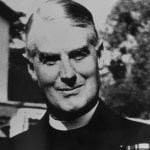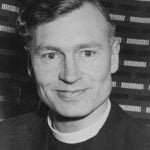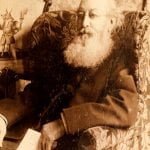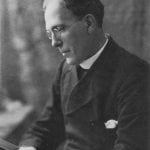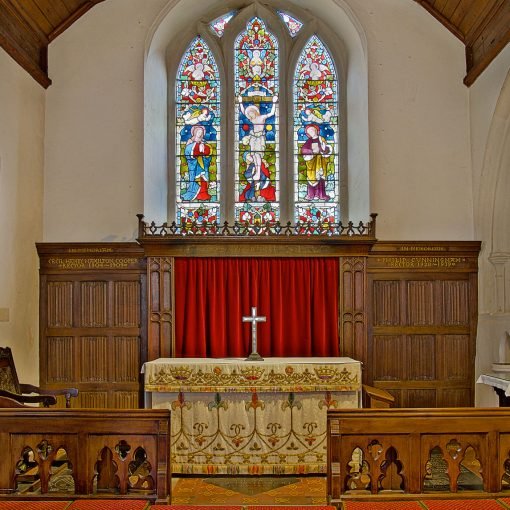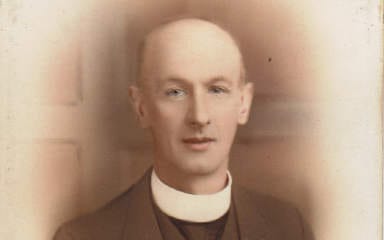Footsteps from the Past
“Understanding the past to find meaning in the present”: Events in the times of Parish Priests of Compton All Saints
- George Fawkes, rector from 1958 to 1973
- Nigel Ovenden, the last rector to live in Compton
- Charles Wickham, rector from 1872 to 1902
- Philip Cunningham, Rector of Compton & Shawford 1928-1939
Table of Contents
In this series of articles, we are looking at the historical events around the times of All Saints (formerly All Hallowes) Church and its named priests in Compton.
Part 1 (February 2016) concerns the beginnings of Christianity in the area and the building of the churches, through turbulent times, including the Black Death until the death of Henry IV in 1413. Then Part 2 (March 2016) deals with the period of the Tudor Reformation; Part 3 covers the Civil War and the Restoration; Part 4 Georgian expansion, Victorian Empire, agricultural & industrial revolutions; and Part 5 from Edward VII to Elizabeth II.
We have shown the “footsteps” in a table, to help match the parish priests (names listed in church) against the ruling monarch at the time and some significant events both locally and nationally.
Part 1 Beginnings. 600-1400
This “beginning” shows when Christianity first came to the area. The original Saxon church was probably built around the time of King Alfred. The stone church dates from around 1160.
Compton was a farming hamlet with the old Roman road (The King’s Highway) running by it. The fields were in the valleys, with common land at Church Fields, Mead Furlong & Hurdle Way. The “Closes” were rented out by the Prior (Cathedral) but much of the Downland was still covered in forests, with some emerging clearings. Generally, Compton was fairly well insulated from national events, but was occasionally affected by marauding gangs, crop failures, famine and by the plague. Church services would have been in Latin; very few people would have been literate and villagers would not have travelled far from home.
Part 2 Tudors – the Reformation
This period of the Tudors and the Reformation was a turbulent time nationally. But in many ways, the Compton community was able to stay relatively stable, despite the shifts between Catholicism and Protestantism, and the dissolution of monasteries. However, one significant event was the martyrdom of Revd John Philpott from Compton Place. Austin Whitaker writes:
The village must have been shaken by the martydom of the Revd. John Philpott, the archdeacon of Winchester, in 1555; he was the son of the squire Sir John Philpott, and broke away from the traditional Catholic faith of his family. He was a man of uncompromising views, always ready to defend them, and his courage in facing death at the stake is dramatically honoured by a golden circle of flame around his name in a fine family-tree of 1620.
Locally, the community had problems with the “Kings Highway” between Compton and Otterbourne. It was often impassable and villagers were often forced to make repairs. Also, the Parish Priest was often absent, and curates would run the church.
Part 3 Civil War and the Restoration. 1603 to 1714
The 17th C can be described as “stirring times” with much political agitation. The parish saw clashes between the opposing forces of the King and Parliament and penal measures directed spasmodically against a Roman Catholic minority. They were often called “recusants” and were given fines for not attending church. Priest Thomas Hackett appears to have steered a “steady ship” during this period with Priest John Webb steadying it until the next period of change.
1651: A Royal visitor. Drew records that
There seems to be little doubt that on Sunday, October 12th there passed through the parish a tall dark young man ’over two yards high’, and on whose head there was a price of £1000.
This was King Charles II fleeing from the debacle of Worcester and seeking a port where a ship might be found to carry him back to France.
He had discarded the ‘old sweaty leather doublet, green threadbare coat and greasy steeple hat without band or lining’ which had formed his first disguise, and was now dressed more decently in ‘a suit and cloak of country grey and a high black hat’.
Attended by one companion only he had left Heale House, near Old Sarum, at 3 a.m. that morning and he arrived near Hursley about noon.
He is known to have crossed the Itchen near Twyford and his route must have been either by Shawford or by the old ford at the Malm.
Part 4. Georgian expansion, Victorian Empire, agricultural & industrial revolutions
The 18/19th Centuries were times of significant changes in the role of monarchy, parliament, an expanding world and European rivalry. They saw improved communication with roads, carriages, post, canals and eventually railways, matching the march of agricultural and industrial revolution. Compton and Shawford was not immune from these changes.
Part 5. Edward VII to Elizabeth II
The 20th century and into the 21st century has been a time of significantly accelerating change and a fair degree of turmoil, with two World Wars, industrial expansion, space exploration and rampant communication in an ever-shrinking world. These are times of significant challenges, social, political and spiritual.
Timeline
Usage Notes:
- You can scroll through the table, or search for people and events by name.
- To search the table for any mention of the Philpotts, enter Philpott in the search box. To look for a specific phrase such as John Philpott, enter “John Philpott” (with quotes) in the search box.
- A search on John Philpott (without quotes) will retrieve entries containing the words John and Philpott not necessarily next to each other.
- If you are using a smartphone, the table is probably easier to read in landscape mode.
| Date | Monarch | Priest | Significant Events |
|---|---|---|---|
| 591 | St.Augustine Christian Missionary England | ||
| 633 | St.Birinus: Christian Missionary to Winchester | ||
| 611-641 | Cynegils.W. Saxon | King Cynegils baptised in 633. | |
| 666-675 | Cenwealh.W. Saxon | Starts Old Minster, estate of 7 leagues distance | |
| 676 | Bishop Haeddi. 1st Bishop of Winchester | ||
| 860-871 | Aethelred | St.Swithun dies in 861 | |
| 871-899 | Alfred the Great | monks | Likely Saxon Church in Compton, wooden structure on ancient stones. Alfred translates the 10 commandments (Latin into Old English) |
| 899-925 | Edward the Elder | monks | King of all Britain. Starts New Minster. |
| 946-955 | Eadred | monks | St. Dunstan brings crown & state together |
| 1016-1035 | Cnut | monks | Remains in Winchester Cathedral |
| 1042-1066 | Edward Confessor | monks | |
| 1066-1087 | William Conqueror | monks | Norman conquest. Domesday Book 1085-6. 9 churches in Manor of Chilcomb, incl Compton. 1079 New Cathedral starts under Prior Simeon |
| 1087-1100 | William II Rufus | monks | Killed in New Forest taken to Winchester via Silkstede, Compton/Shawford. "Red Lane". |
| 1100-1135 | Henry I | monks | Elected King in Winchester |
| 1135-1154 | Stephen | monks | |
| 1154-1189 | Henry II | monks | By 1160 Compton stone church is built, north door of this date as is the font. "All Hallowes" 1170 Thomas Beckett murdered in Canterbury |
| 1189-1199 | Richard I Lionheart | monks | Crusades. 1195 origin of JPs |
| 1199-1216 | John | monks | 1215 Magna Carta |
| 1216-1272 | Henry III | Hugo de Lavington | 1st Parliament of County Representatives. |
| 1272-1307 | Edward I | Henry Simplingham | |
| 1289 | Edward I | William de Essex | 1290 Jews are banished, did not return until 17.C |
| 1304 | Edward I | John de Bloyou | 1300 Chancel arch in Old church. |
| 1305 | Edward I | Oger de Kernicke | Scottish uprising. W Wallace & R Bruce. |
| 1307-1327 | Edward II | William d Bloyou | 1307 Silkstede pigeon house, part still survives.1314. crops fail, famine & disease |
| 1316 | Edward II | W de Staunforde | |
| 1317 | Edward II | W de Farnham | |
| 1327-1377 | Edward III | Robert Parson | 1327 start of local taxation. Unsettled times |
| c 1337 | Edward III | William Gaspays | 1338 start of 100yrs war with France |
| c 1340 | Edward III | William d Meon | 1345 Battle of Crecy. English bowmen. |
| 1347 | Edward III | Nicholas de Winton | 1348 The Black Death. Third of population dies & family names disappear from Compton register |
| 1349 | Edward III | John Loke (or Lok)* | |
| 1349 | Edward III | Richard Habbegod | (* probable deaths from plague) |
| 1354 | Edward III | John de Kymberlee (or Kimberlee) | shortage of land labour & farmers. |
| 1357 | Edward III | Hugh de Morton | appearance of farmer priests |
| 1361 | Edward III | John Wormenhale | |
| 1361 | Edward III | Michael Dunkeved | 1362 English language set in statute for use in courts of Law. Services still in Latin. |
| 1372 | Edward III | John Stauntone | |
| 1375 | Edward III | Thomas Tynny (or Tynne) | 1377 John Wycliffe reforming politician and theologian. Followers "Lollards" persecuted |
| 1377-1399 | Richard II | William Grateley | 1381 Peasants Revolt. Essex & Kent |
| 1381 | Richard II | Wycliffe's translation of the Bible in English | |
| 1399-1413 | Henry IV | William Ruddock | 1411. 1400 Laws passed on heresy |
| 1412 | Henry IV | John Cranburne | 1405 persecution & alienation of clergy. |
| 1413-1422 | Henry V | John Cranburne | Long serving priest. "Kings Highway" "Holeway" impassable owing to flooding. Villagers digging for chalk? Ordered to repair. Henry starts written English. Battle of Azincourt (fleet sails from Southampton with archers.) |
| 1422-1461 | Henry VI | John Cranburne | Jeanne D'Arc. 1455 War of Roses starts. Philpotts arrive to build Compton Place. |
| 1461-1483 | Edward IV | John Boucher | 1466. 1467 Kings Highway danger to use. |
| -1469 | Edward IV | Walter Dyar | 1477 Caxton's first printing press. |
| -1480 | Edward IV | Thomas Apthorp | |
| -1483 | Edward V | Brian Hulme | Edward one of murdered princes in Tower |
| 1483-1485 | Richard III | Brian Hulme | 1485 Battle of Bosworth Richard killed by Tudors |
| 1485-1509 | Henry VII | Richard Maker | 1493. Thomas Silksted became Prior of St. Swithun's Cathedral Winchester. Builds Silksted Manor House as Prior's country residence(300yr) |
| 1493 | Henry VII | William Eades | 1501 Henry's son marries Catherine of Aragon. 1502 Arthur dies & Catherine passes to Henry 8. |
| 1501 | Henry VII | William Cadew (rector) John Johnson alias Scott (parish priest) | 1507. Malms is main common land in Compton |
| 1509-1547 | Henry VIII | David Sybald (or Sibbald) | 1517.David Sybald (or Sibbald), a Franciscan who upheld his beliefs until his death in 1534. Cardinal Wolsey is Henry's Chancellor. Martin Luther makes his proclamation against Rome. |
| -1521 | Henry VIII | David Sybald (or Sibbald) | Henry to divorce Catherine to marry Anne Bolyn |
| -1525 | Henry VIII | David Sybald (or Sibbald) | William Tyndale prints English translation of New Testament, "so ploughboys can learn to read Bible". He is martyred. |
| -1530 | Henry VIII | David Sybald (or Sibbald) | Wolsey goes, Henry abandons Rome and forms Church of England |
| -1534 | Henry VIII | David Sybald (or Sibbald) | Although it was dangerous to do so, David Sybald/Sibbald left all his property to the strict Fanciscan Observants. The will was overturned by decision of Thomas Cromwell that the money should be disposed of at the King's pleasure. |
| -1534 | Henry VIII | Wiliam Philpott | Cranmer is Archbishop. Henry marries Anne. Thomas Cromwell is Vicar General. Act of Supremacy made law. |
| -1536 | Henry VIII | Anthony Barker | Is prebendary at Winchester Cathedral, has two curates Walter Welche & William Thomas. Dissolution of monasteries. Anne beheaded. Henry marries Jane Seymore, Edward born 1537. Jane dies. |
| -1539 | Henry VIII | Anthony Barker | Winchester Priory dissolved, Cathedral gains a Dean & Chapter. The Six Articles of Protestantism imposed. Compton still known as All Halowdes. |
| -1540 | Henry VIII | Anthony Barker | Henry marries Anne of Cleves & soon divorces her to marry Catherine Howard. Cromwell is executed. |
| -1542 | Henry VIII | Anthony Barker | Henry has Catherine beheaded and in 1543 marries Catherine Parr who survives him. d 1547 |
| 1547-1553 | Edward VI | Anthony Barker | Cranmer publishes the Catechism & Book of Common Prayer & enforces Act of Uniformity |
| -1551 | Edward VI | John Erle | A former monk & Lay Clerk at Winchester Cathedral. He manages to balance the faiths. |
| -1553 | Lady Jane Grey | John Erle | Cranmer publishes the 42 Articles of Religion |
| 1553-1558 | Mary I | John Erle | Mary restores the Mass & begins to persecute Protestants as heretics. John Erle becomes sacristan at Winchester Cathedral |
| -1554 | Mary I | John Erle | Mary marries Philip of Spain in Winchester Cathedral |
| -1555 | Mary I | John Erle | Revd John Philpott (Compton Place) Archdeacon of Winchester accused of heresy, burnt at stake. |
| 1558-1603 | Elizabeth I | John Erle | Restores Church of England. |
| -1559 | Elizabeth I | John Coxe | 2nd Act of Supremacy, clergy to sign an oath |
| -1560 | Elizabeth I | David Padye | Prebendary of St Pauls & Winchester Cathedrals |
| -1562 | Elizabeth I | Thomas Odill | Prebendary of Winchester. Kings Highway again impassable. Villagers ordered to repair it. |
| -1564 | Elizabeth I | Thomas Odill | Birth of Shakespeare. |
| -1566 | Elizabeth I | Edward Walker | Curate John Wright. |
| -1574 | Elizabeth I | Robert Raynolds | Former Master St Cross. Non-resident of Compton uses Curates Walter Heycrest & Thomas Stemp. |
| -1587 | Elizabeth I | Robert Raynolds | Mary Q of Scots executed leaving son James. |
| -1588 | Elizabeth I | Robert Raynolds | Spanish Armada defeated |
| -1595 | Elizabeth I | John Harmer | John Harmer was also Professor of Greek at Oxford, Headmaster and Warden of Winchester College and one of the translators of the Authorised Version |
| 1603 | Elizabeth I | John Harmer | Elizabeth dies at 69yrs, James I named successor. |
| 1603 | James I | John Harmer | Compton has 70 communicants |
| 1603 | James I | John Harmer | Walter Raleigh tried in Winchester. Executed. Scholars sent to lodge in Silkstead so lawyers and courtiers in Winchester for the trial could stay at the college. |
| 1604 | James I | John Harmer | Gunpowder Plot. King James Bible printed. |
| 1606 | James I | John Harmer | Two colonies founded in Virginia. |
| 1613 | James I | Abraham Browne | Prebendary of Winchester Cathedral |
| 1620 | James I | Abraham Browne | "Mayflower" sails for America. |
| 1623 | James I | Abraham Browne | Catholics allowed to worship in private houses. |
| 1625 | Charles I | Abraham Browne | Autumn plague rages in Winchester. College students sent to Silkstead for 17 months. |
| 1627 | Charles I | James Wedderburn | Also Prebendary of Ely & Wells & vicar of Mildenhall & Fulbourn. William White, curate. |
| 1628 | Charles I | James Wedderburn | New Barn area still in forest. |
| 1632 | Charles I | James Wedderburn | Goldfinch family living at Manor Farm House. |
| 1633 | Charles I | James Wedderburn | Turmoil in Parliament, Archbishop Laud gives leniency to Catholics. |
| 1636 | Charles I | John Ramsey then Thomas Hackett | Dr Wedderburn becomes Bishop of Dunblane. |
| 1640 | Charles I | Thomas Hackett | Charles dissolves Parliament, sets up new one. Severe measures passed against Catholics. |
| 1642 | Charles I | Thomas Hackett | Parliament in chaos. Start of Civil War. Silkstead Manor in hands of Harris family 160yr |
| 1643 | Charles I | Thomas Hackett | Government of church by Bishops abolished |
| 1645 | Charles I | Thomas Hackett | Oliver Cromwell head of New Model Army. Storms Winchester Castle. Troops billeted in Compton. |
| 1649 | Charles I | Thomas Hackett | Charles, tried, condemned & executed |
| 1650 | Monarchy abolished | Thomas Hackett | also House of Lords abolished. Survey of church estates. |
| 1651 | Monarchy abolished | Thomas Hackett | Drew records that "on Sunday October 12th there passed through the parish a tall dark young man 'over two yards high', and on whose head there was a price of £1000. This was King Charles II fleeing from the debacle of Worcester". In disguise he had left Old Sarum at 3am, reached Hursley by noon along what is now the Monarch's Way. He crossed the Itchen at Shaldefud (Shawford), or possibly the ford at the Malm en route to a channel port and a ship to France. Parish instructed to repair Kings Highway & church railings. |
| 1653 | Protectorate | Thomas Hackett | Cromwell made Lord Protector |
| 1656 | Protectorate | Thomas Hackett | Parliament recalled. |
| 1658 | Protectorate | Thomas Hackett | Cromwell dies handing over to son Richard, who resigns. Eventually lived in Hursley where he is buried in church yard. |
| 1660 | Charles II | Thomas Hackett | Restoration of Monarchy. |
| 1660 | Charles II | Thomas Hackett | Philpotts leave Compton Place sold to Sir Henry Worsley for another 40 years |
| 1661 | Charles II | James Holloway | Thomas Hackett buried in old church chancel. Corporation Act, persecution of dissenters |
| 1662 | Charles II | James Morecroft | 2,000 non-conforming clergy resign to become Presbyterians. Hearth Tax implemented. |
| 1665 | Charles II | James Morecroft | Great plague breaks out & reaches Hursley. |
| 1666 | Charles II | James Morecroft | Great Fire of London. |
| 1667 | Charles II | William Burt | Milton's "Paradise Lost" printed. Dr Burt, was warden Winchester College & Prebendary |
| 1677 | Charles II | John Barton | Former Curate. 92 conformists & 14 papists registered in the village. |
| 1678 | Charles II | John Barton | Burial records began (burying in woollens). Collections for St Pauls Cathedral, captives in Algiers & protestants in Poland & France. "The Compton people were(are) generous folk." |
| 1683 | Charles II | John Webb | Lived 38years at Parsonage. |
| 1685 | James II | John Webb | Monmouth rebellion leading to Bloody Assizes with Judge Jeffreys. Some held in Winchester. |
| 1687 | James II | John Webb | Declaration of Indulgence proclaims liberty of conscience. |
| 1688 | James II | John Webb | James deserted by family & faced with a Protestant revolt, flees to France. |
| 1689 | William III & Mary II | John Webb | Act of Settlement for Royal succession. Country unsettled. Ireland invaded. Battle of The Boyne |
| 1690 | William III & Mary II | John Webb | Massacre at Glencoe. At war with France. |
| 1694 | William III & Mary II | John Webb | Mary dies. Jacobite Rebellion. |
| 1695 | William III & Mary II | John Webb | Register of Baptisms & Marriages started |
| 1702 | Anne | John Webb | Compton Place demolished., acreage includes Shawford Close up to the ford at Shawford.. |
| 1712 | Anne | John Webb | European wars with army led by Duke of Marlborough. Armistice with France. |
| 1714 | George I | John Webb | Start of Hanoverian dynasty. |
| 1710 | George I | John Webb | Itchen Navigation "Barge Canal" completed. |
| 1714 | George I | John Webb | Composer Handel comes to England. |
| 1721 | George I | John Thistlewaite | Canon of Chichester. Curate William Harvey. Walpole government. |
| 1722 | George I | John Thistlewaite | Wascelyn-Philpott land sold. "Little Cranford Cottage" Shawford existed |
| 1724 | George I | Charles Scott | Rector for 38 yrs. Built "Red House" parsonage next to church. Compton Population 130. |
| 1727 | George II | Charles Scott | Unpopular King. Wife Caroline more effective. Time of composer JS Bach & highwayman Dick Turpin. 1731 Gallery built at west end of old church for musicians. |
| 1739 | George II | Charles Scott | John Wesley founded Methodism. War of Jenkin's Ear against Spain. |
| 1742 | George II | Charles Scott | Permission granted to "burn, bake, plough & till" land at Southdown.("Bakelands") First performance of Handel's "Messiah". |
| 1744 | George II | Charles Scott | Difficult years for farming. War with France. |
| 1745 | George II | Charles Scott | "Bonnie Prince Charlie" defeated at Culloden |
| 1750 | George II | Charles Scott | Agricultural revolution with bigger farms and new technology. Beginnings of Industrial revolution. |
| 1755 | George II | Charles Scott | Samuel Johnson's dictionary printed |
| 1757 | George II | Charles Scott | England characterised by Hogarth's paintings. British adventures in India(Clive),Canada(Wolfe) |
| 1759 | George II | Charles Scott | British Museum opens to the public. |
| 1760 | George III | Charles Scott | |
| 1763 | George III | John Mitchell | Robert Shipman curate. |
| 1765 | George III | John Shipman | Curate George Huntingford later Bishop of Hereford buried at Compton Church. Malt Houses by Shawford bridge & Parsonage Barn(1771) Last record of full Rogation walk around parish. Private school of William Goldfinch moves to Twyford. |
| 1768 | George III | John Shipman | Watt's steam engine, Arkwright's spinning frame. |
| 1772 | George III | John Shipman | Slavery abolished in England |
| 1773 | George III | John Shipman | Start of American War of Independence. |
| 1775 | George III | Newton Ogle | Dean of Winchester. Captain Cook's tour. |
| 1776 | George III | Thomas Rickman | A methodical rector. |
| 1780 | George III | Thomas Rickman | Catholic Relief Bill |
| 1781 | George III | Philip Williams | Prebendary of Winchester & Canterbury, Chaplain to Speaker House of Commons. Sally (Sarah) his wife manages church in his absence. ref Shurlock |
| 1783 | George III | Philip Williams | Construction begins on Compton-Otterbourne Turnpike road (follows Roman road). Parliament of Pitt the younger. |
| 1787 | George III | Revd Williams returns | Sarah Williams dies. Memorial in church. Golden age of horse & carriages 1780-1840 |
| 1788 | George III | Philip Williams | First recorded cricket match in village. George III deemed insane. Travis of Silkstead employs poor children of parish in flax spinning. |
| 1789 | George III | Philip Williams | French Revolution |
| 1790 | George III | Philip Williams | Poor house in village at Shawford (nr current hall) |
| 1798 | George III | Philip Williams | Rise of Emperor Napoleon, threatens England |
| 1803 | George III | Philip Williams | Silkstead Manor demolished.(bits remain) |
| 1805 | George III | Philip Williams | Battle of Trafalgar |
| 1809 | George III | Philip Williams | At war with Spain |
| 1812 | George III | Philip Williams | Napoleon invades Russia & is defeated by winter. |
| 1815 | George III | Philip Williams | Battle of Waterloo. Napoleon defeated. Corn Law. |
| 1817 | George III | Philip Williams | First savings banks established. Industrial strikes. |
| 1820 | George IV | Philip Williams | Unrest in agriculture, bad time for farmers. |
| 1829 | George IV | Philip Williams | Stevenson's "rocket" steam engine. |
| 1830 | William IV | John Old Zillwood | Revd Williams dies at 88, after 50yrs at Compton. |
| 1832 | William IV | John Old Zillwood | First steam vehicle arrives in Compton. 52 Houses in the parish. Chequers Inn at corner of Compton St & main rd, opposite blacksmiths & across from the wheel-wright. |
| 1833 | William IV | John Old Zillwood | Abolition of slavery. First Education Grant. Factory's Act guarding rights of children. |
| 1834 | William IV | John Old Zillwood | Poor Law increase number of workhouses |
| 1836 | William IV | John Old Zillwood | Reform of marriage laws. Now church & Chapel. Railway line being built through the village using mainly Welsh navvies |
| 1837 | Victoria | John Old Zillwood | William is succeeded by his niece Victoria. Poor Law gives rise to Socialism & Chartism |
| 1838 | Victoria | John Old Zillwood | Compton Church elementary school established. |
| 1839 | Victoria | John Old Zillwood | First passenger train in Shawford on 10th June. |
| 1840 | Victoria | John Old Zillwood | Penny post. Victoria marries Albert |
| 1841 | Victoria | John Old Zillwood | Canada united.1st Afghan war |
| 1843 | Victoria | John Old Zillwood | Scottish church schism leads to Free Kirk |
| 1845 | Victoria | John Old Zillwood | Irish potatoes famine compounds poverty & in a year quarter million people die of famine. |
| 1851 | Victoria | John Old Zillwood | The Great Exhibition at Crystal Palace. |
| 1853 | Victoria | John Old Zillwood | Lyne family at Compton Manor Farm for next 30yrs |
| 1854 | Victoria | John Old Zillwood | Crimea War & Florence Nightingale's nurses. |
| 1857 | Victoria | John Old Zillwood | Continued unrest in India |
| 1860 | Victoria | John Old Zillwood | Maori Wars in New Zealand |
| 1861 | Victoria | John Old Zillwood | American Civil War which ends in 1864 |
| 1868 | Victoria | John Old Zillwood | Disraeli administration followed by Gladstone. Chequers Inn closes and becomes a dairy until 1890. |
| 1870 | Victoria | John Old Zillwood | Elementary Education Act |
| 1871 | Victoria | Charles Wickham | Corn at Compton Farm mechanically threshed. |
| 1872 | Victoria | Charles Wickham | Ballot Act. |
| 1879 | Victoria | Charles Wickham | Improvements to old church, gallery dismantled, 13thC fresco & windows revealed, new E window |
| 1882 | Victoria | Charles Wickham | Shawford Station opens. Area now fashionable for building. Until then an Inn, a mill, poor houses & ancient cottages overlooking the river. |
| 1884 | Victoria | Charles Wickham | Sudanese war |
| 1888 | Victoria | Charles Wickham | Compton Farm had 20 horses & 20 men. Everyone went to church on Sunday. Women shopped in Winchester walking there and back. 1888 Local Government Act creates County Councils. |
| 1894 | Victoria | Charles Wickham | 1894 Local Government Act creates Parish Councils, grants additional rights to women |
| 1896 | Victoria | Charles Wickham | Parish Hall opened on 16 Dec, built for ?750 including land. First in the county under the 1894 LGA |
| 1899 | Victoria | Charles Wickham | Southdown sold by Ecclesiastical Commission for housing. Boer War in S Africa. |
| 1901 | Victoria | Charles Wickham | Victoria dies aged 81 years. |
| 1901 | Edward VII | Charles Wickham | London Underground Railway |
| 1902 | Edward VII | Alfred Blake | Memorial window to Revd Wickham dedicated 21 December 1902. Women's suffragette movement 1903 |
| 1904 | Edward VII | Cecil Cooper | Japan and Russia at war, Entente Cordiale, Panama canal |
| 1905 | Edward VII | Cecil Cooper | Major church extension blends old with new. Memorial window to Revd Wickham and Good Shepherd window reinstalled. |
| 1908 | Edward VII | Cecil Cooper | Organ put into church. Music time of Elgar & V Williams. |
| 1909 | Edward VII | Charles Durham | Revd Cooper goes on to be Archdeacon of York & Dean of Carlisle. Returns to live in Compton. Cars produced. 1st air flight across English Channel. |
| 1910 | George V | Charles Durham | 1912 Titanic sinks. White Star Line plates in Village Hall. |
| 1914 | George V | Charles Durham | Start of 1st World War. Thousands of soldiers march along main road to Southampton, stop for refreshments by top of Shawford Down. Irish Soldiers guard railway. |
| 1915 | George V | Charles Durham | Village welcomes Belgium refugees from Malines. Royal Artillery stationed on Southdown. Hospital in Village Hall. |
| 1917 | George V | John Blackett | Russian Revolution. |
| 1918 | George V | John Blackett | End of Hostilities 11:00 11/11/1918. 10 million dead, 17 from village. Wayside Cross erected. Women get the vote. |
| 1919 | George V | John Blackett | Great War formal end with Treaty of Versailles. 1st Atlantic air flight. |
| 1921 | George V | John Blackett | Shawford Down War Memorial dedicated 4 April |
| 1922 | George V | John Blackett | General strike/depression. Ireland partitioned. |
| 1928 | George V | Philip Cunningham | House building at Attwoods Drove & Martins Field |
| 1930 | George V | Philip Cunningham | Mr. Cunningham, who had previously been rector of Cranleigh, Surrey, and Rural Dean of Guildford. was made an Honorary Canon of Winchester Cathedral - the first rector of Compton to receive this distinction. |
| 1932 | George V | Philip Cunningham | Great depression. Rise of Hitler & Mahatma Gandhi |
| 1936 | Edward VII | Philip Cunningham | King abdicates. Start of Spanish Civil war. |
| George VI | Philip Cunningham | 1937 Rectory sold and new one built in garden. Start of A33 Winchester bypass which affects Compton. | |
| 1939 | George VI | Philip Cunningham | 2nd World War starts. |
| 1940 | George VI | Edwin Utterton | Grandson of Mary Sumner, founder Mother's Union. See Mary window in SW aisle. Stray bomb falls near church. |
| 1945 | George VI | Edwin Utterton | War ends with millions dead, 14 from the village. Atom bombs on Hiroshima & Nagasaki. Shawford Mill closes. |
| 1946 | George VI | Edwin Utterton | NHS begins. |
| 1947 | George VI | Edwin Utterton | Transport Nationalisation, 1st Scout Troop in Village. Memorial Playing Field purchased for the parish from Judd for 춲540. |
| 1948 | George VI | Edwin Utterton | Economic & Social Treaty of Brussels. |
| 1951 | George VI | Henry Burdett | Festival of Britain |
| 1952 | Elizabeth II | Henry Burdett | 1st television broadcast to nation |
| 1953 | Elizabeth II | Henry Burdett | County Council buys Shawford Down to guarantee its future as an open space. |
| 1955 | Elizabeth II | Henry Burdett | Pageant of Parish History. 1956 Non Conformist Chapel in Shawford closes. |
| 1958 | Elizabeth II | George Fawkes | Retired Naval chaplain. West window memorial. |
| 1962 | Elizabeth II | George Fawkes | Telstar Communication satellite. |
| 1963 | Elizabeth II | George Fawkes | President Kennedy assassinated. |
| 1965 | Elizabeth II | George Fawkes | Death of Sir Winston Churchill. Vietnam War & troubles in Ireland. |
| 1969 | Elizabeth II | George Fawkes | By-pass extended from Compton to Southampton. Man sets foot on the moon. |
| 1971 | Elizabeth II | George Fawkes | Decimal currency |
| 1973 | Elizabeth II | Nigel Ovenden | Former Fleet Air Officer. Last priest to live in Compton. Country joins EEC. Energy crisis - 1974 3-day week |
| 1977 | Elizabeth II | Nigel Ovenden | Queen's Jubilee. |
| 1979 | Elizabeth II | Nigel Ovenden | 1st female PM Margaret Thatcher. |
| 1982 | Elizabeth II | Nigel Ovenden | Falklands war with Argentina. |
| 1984 | Elizabeth II | Nigel Ovenden | Coal miners strikes. Social unrest. |
| 1987 | Elizabeth II | Philip Barrett | First Rector of Compton & Otterbourne. Much respected priest, scholar and pastor. 1989: Hurricane sweeps southern England, fall of Berlin Wall, freedom in Europe. 1994: Channel Tunnel opens, Nelson Mandela first President of a united South Africa. |
| 1994 | Elizabeth II | Philip Barrett | Completion of the M3 motorway, which carves its way through Compton & Shawford; bridges link the villages. |
| 1999 | Elizabeth II | Edward John Widdows | Priest whose high church leanings didn't sit well with the congregation's established practice. |
| 2003 | Elizabeth II | Paul Baird | Much loved & respected by his flock. Harshly treated by church authorities. |
| 2008 | Elizabeth II | William Prescott | First Rector of Compton, Hursley & Otterbourne. Very conscientious, very good teacher and spiritual leader. |
| 2016 | Elizabeth II | William Prescott | Queen attains 90 years of age & has served 63 years as monarch, the longest serving monarch in our history. |
| xxxxxxxxxx | end of table |
References
- “The Speaker’s Chaplain & The Master’s Daughter” Barry Shurlock. SBN 978-0903330282.
- Whitaker, Austin. “Compton & Shawford” 1985 Large & Whitaker. Boyatt Wood Press, Southampton.
- Drew J S. “Compton Near Winchester” Warren & Son Ltd., 1939
- Course E. “The Itchen Navigational” Southampton University 1983
- Corcoran C & Matthews M. “The Five Mills of Twyford in 1300”. https://lhs.comptonshawford.uk/2017/04/the-five-mills-of-twyford-in-1300/
- The Trial of Sir Walter Ralegh: a transcript https://mathewlyons.wordpress.com/2011/11/18/the-trial-of-sir-walter-ralegh-a-transcript/
- The Shawford Serendipity Trail,“a historical treasure-hunt in Compton and Shawford”, Tom Threlfall, 1997. https://comptonshawford-pc.gov.uk/sport-and-leisure/walking/the-shawford-serendipity-trail/
- EE Project: Digital correspondence of Philip Williams, 2012
http://www.e-enlightenment.com/coffeehouse/project/williams2012/doc01_preface.html - John Harmar (Harmer) http://kingjamesbibletranslators.org/bios/John_Harmar/
- James Wedderburn (Bishop) https://en.wikipedia.org/wiki/James_Wedderburn_(bishop)
- Kelly’s Directory of Hampshire (1898) http://forebears.co.uk/england/hampshire/compton#sid13736
- Foxe’s Book of Martyrs John Philpot
- Compton Clergy of Long Ago – 9 articles by J.S.Drew serialised in the Compton Parish Magazine 1934 – as a pdf or epub
John Wilkinson
Compton & Shawford Local History Group
editor: Adrian Walmsley
Originally published in five instalments in Compton & Shawford Parish Magazine, February-June 2016
This version contains a few minor editorial changes and the search capability is a useful enhancement over the printed version.

